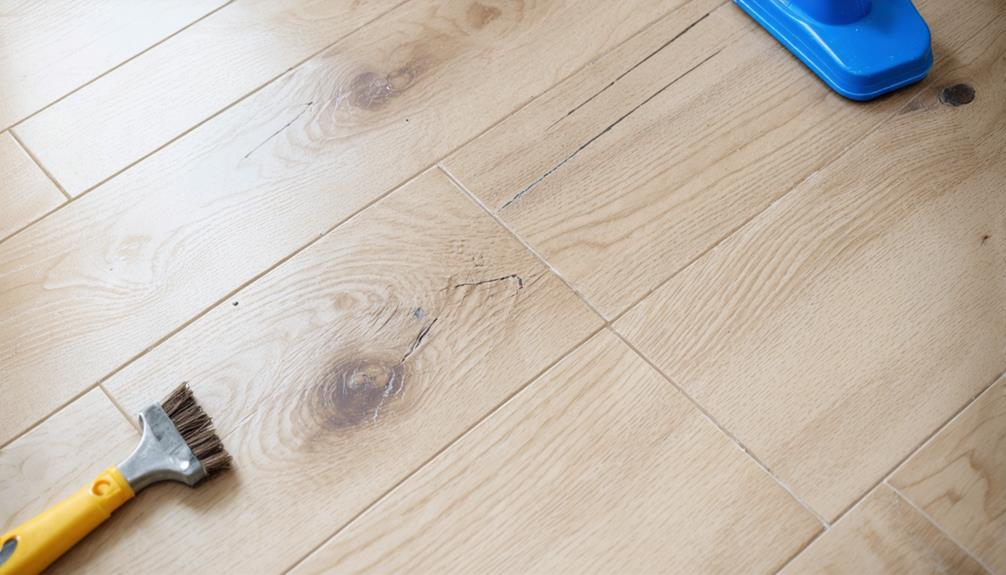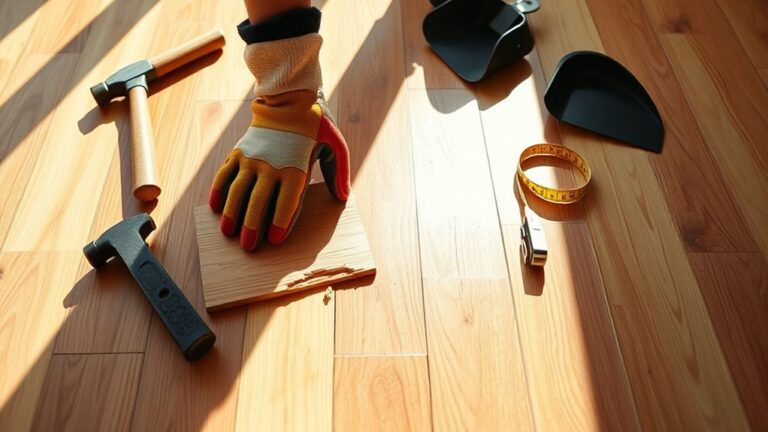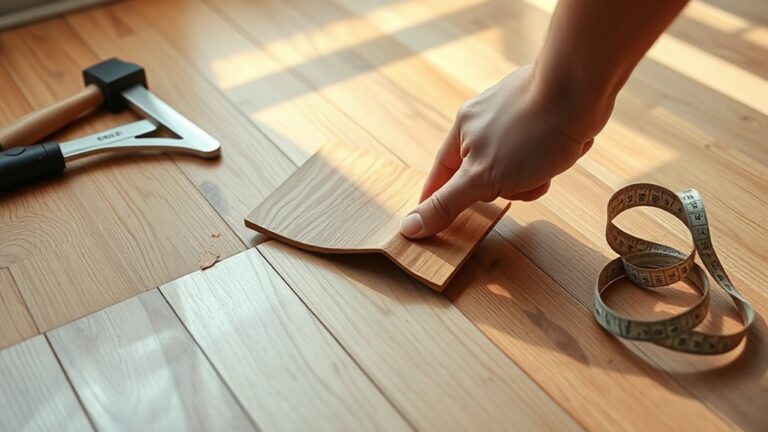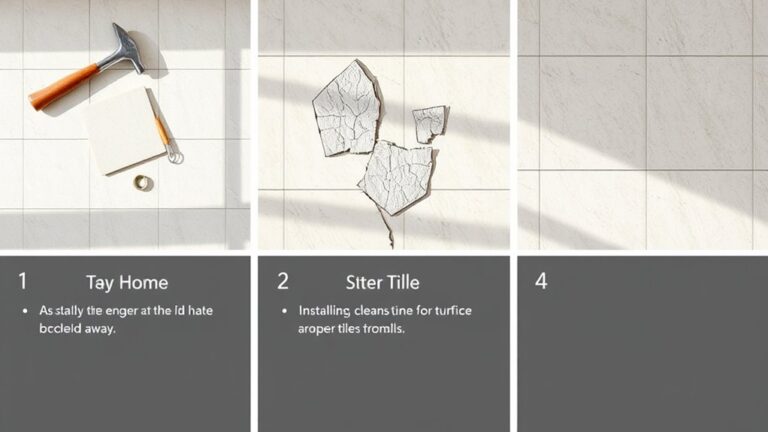Common issues with laminate flooring include moisture damage, surface scratches, and improper installation. To prevent moisture-related problems, maintain indoor humidity levels between 30%-60% and clean up spills immediately. Ascertain you leave at least a 0.25-inch expansion gap around the perimeter to accommodate natural movement. For scratches, use protective mats and consider felt pads under furniture. Always prepare your subfloor properly and follow manufacturer's guidelines during installation. Regular inspections and timely repairs keep your flooring in good condition. By exploring further, you can discover even more effective strategies to enhance and maintain your laminate flooring.
Common Problems With Laminate Flooring
When it comes to the durability of laminate flooring, several common problems can undermine its performance and aesthetic appeal. One of the most significant issues is moisture exposure, which can lead to water damage, causing planks to warp or buckle. To mitigate this, guarantee that you maintain proper humidity levels in your home and promptly address any spills. Another concern is the necessity of expansion gaps; these gaps allow for the natural expansion and contraction of the flooring. Neglecting them can result in buckling and gaps between planks, detracting from the smooth appearance of your laminate flooring.
Poor installation practices can also contribute to common laminate flooring problems. An uneven subfloor or inadequate underlayment may lead to a bouncy or spongy feel underfoot, indicating insufficient support. It's essential to prepare the subfloor correctly before installation to avoid these issues. Additionally, surface damage like scratches and bubbling can occur from heavy foot traffic or unattended spills. To preserve the integrity of your flooring, consider using protective mats and clean up spills immediately.
Lastly, color fading is a concern, particularly in sunlit areas. Investing in UV-resistant layers or strategically placing window coverings can help reduce this effect. By being aware of these common problems and taking proactive measures, you can enjoy your laminate flooring for years to come.
Causes of Laminate Flooring Issues
Moisture and humidity are key factors that can lead to significant issues with your laminate flooring. If you don't allow for proper acclimation and expansion space during installation, you might end up with gaps or buckling over time. Understanding these causes is essential for maintaining the integrity and appearance of your flooring.
Moisture and Humidity Factors
Although laminate flooring offers an attractive and cost-effective solution for many homeowners, factors like moisture and humidity can pose significant challenges. Moisture exposure is the primary culprit behind issues such as warping, buckling, and bubbling, as laminate isn't waterproof and can swell when wet. High humidity levels can also lead to expansion in the boards, resulting in peaking or gapping if proper expansion gaps aren't left during installation.
To prevent moisture damage, it's vital to regularly monitor humidity levels, keeping them between 30% and 60%. Improper acclimation of laminate flooring to your home environment before installation can exacerbate moisture-related problems, so take this preparation step seriously.
Additionally, immediate cleanup of spills is essential to reduce the risk of water damage. Avoid high-moisture areas for installation, such as bathrooms or kitchens, to further protect your laminate floors. By understanding these moisture and humidity factors, you can enjoy the beauty of your laminate flooring without the worry of potential damage. Stay proactive about your home's environment, and your floors will reward you with longevity and aesthetic appeal.
Installation and Acclimation Issues
Proper installation and acclimation of laminate flooring are critical to guaranteeing its longevity and performance. Without proper acclimation to your home's environment, the laminate boards may expand or contract post-installation, leading to warping or gapping. Before you begin installation, make certain your subfloor is level and clean; imperfections can cause bouncy or spongy spots that affect overall stability.
Stick to the manufacturer's installation instructions meticulously. Any deviation can result in common issues like lifting or peaking of the laminate boards. It's also essential to leave adequate expansion gaps around the perimeter of the flooring. These gaps accommodate changes in temperature and humidity, preventing buckling or separation of the boards.
Additionally, choose the right underlayment based on your laminate type and environmental conditions. This can help mitigate moisture issues and reduce sound transmission, ultimately enhancing the flooring's durability and performance. By focusing on these key installation and acclimation aspects, you'll guarantee a more resilient and visually appealing flooring solution that stands the test of time.
Installation Best Practices
Acclimating laminate flooring to your home's environment for at least 48 hours before installation is important for preventing future expansion or contraction issues. This step allows the flooring to adjust to the local moisture content and temperature, reducing the risk of warping. Before you install laminate flooring, verify that your subfloor is clean, dry, and level. Laminate is sensitive to imperfections, and a smooth surface is essential for proper installation.
Follow the manufacturer's specific installation instructions closely, especially regarding the recommended underlayment and expansion gaps. Leaving a minimum 0.25-inch expansion gap around the perimeter is critical, as it accommodates natural movement caused by temperature and humidity changes—one of the most common causes of post-installation problems.
Utilizing the right tools can also make a significant difference. A rubber mallet and tapping block can help fit the planks snugly together without damaging them. Additionally, using a moisture meter before and during installation can help manage moisture levels, guaranteeing that the flooring performs as expected.
Repair Strategies for Common Problems
Even with careful installation, laminate flooring can encounter issues over time. One common problem is peaking, where boards push against each other. To fix this, remove baseboards and create adequate expansion space by cutting the flooring. Verify moldings aren't attached to the floorboards, allowing for necessary movement.
Buckling is another issue, often caused by excess moisture. Start by identifying the moisture source and verify a proper moisture barrier is in place. Once the affected area is dry, replace any damaged boards to restore the floor's integrity.
Gapping can occur, especially if the flooring wasn't properly acclimatized before installation. To prevent further separation, maintain consistent temperature and humidity levels in your home. If gaps do appear, you may need to re-evaluate your installation conditions.
For cosmetic issues like chipped corners, laminate floor repair kits are your best friend. These kits can help you fix minor damage effectively. For severely damaged boards, carefully lift the affected planks, replace them, and verify proper alignment during reinstallation.
Regular inspections are key to maintaining your laminate flooring. Look for signs of damage and take preventive measures, such as using floor mats and felt pads, to protect your floors from scratches and wear. By addressing these common problems proactively, you can keep your laminate flooring looking great and functioning well for years to come.
Maintenance and Care Tips
To keep your laminate flooring in top condition, regular maintenance and care are essential. Proper humidity levels are vital; aim to maintain them between 30% and 60%. This helps prevent warping and gapping caused by excessive moisture or dryness.
Here are some practical tips for maintaining your laminate flooring:
| Maintenance Task | Frequency | Purpose |
|---|---|---|
| Inspect for damage | Monthly | Catch issues early to prevent worsening |
| Clean spills immediately | As needed | Prevent moisture damage |
| Use floor mats | Always at entryways | Reduce dirt and scratches |
| Acclimate planks | Before installation | Adjust to room conditions |
When cleaning, use minimal water. A damp mop is your best friend—avoid wet mopping to keep moisture from soaking into the laminate. For ongoing care, regularly inspect your flooring for any signs of damage. Additionally, equip furniture legs with felt pads to minimize surface damage from movement and heavy items.
Lastly, always verify that your laminate planks have acclimated to your home environment for at least 48 hours before installation. This adjustment will greatly reduce future expansion issues. By following these maintenance tips and caring for your laminate flooring, you'll enjoy its beauty and durability for years to come.
Preventive Measures for Longevity
To guarantee your laminate flooring lasts, it's essential to adopt regular cleaning practices and proper acclimatization techniques. By maintaining a consistent cleaning routine and preparing the flooring for installation, you can greatly reduce wear and tear. These preventive measures will help you keep your laminate looking great and functioning well for years to come.
Regular Cleaning Practices
While maintaining the beauty and durability of your laminate flooring might seem challenging, adopting regular cleaning practices can greatly extend its lifespan. By implementing a consistent cleaning routine, you can prevent wear and tear, reduce the risk of moisture damage, and keep your floors looking pristine.
Here are four essential practices to follow:
- Dry Mop or Vacuum: Regularly remove dirt and debris to prevent scratches and surface damage. A soft-bristle broom or vacuum cleaner designed for hard surfaces works best.
- Damp Mop with a Suitable Solution: Use a damp mop with a mild cleaning solution specifically formulated for laminate flooring. Avoid excess water to prevent moisture damage.
- Address Spills Immediately: Clean up any spills right away to minimize the risk of water seeping into seams, which can lead to bubbling and warping.
- Use Floor Mats: Place mats at entryways to greatly reduce the amount of dirt tracked onto your floors, helping to maintain their appearance and longevity.
Proper Acclimatization Techniques
Maintaining laminate flooring involves more than just regular cleaning; proper acclimatization is key to guaranteeing its longevity and performance. Before installation, let the laminate planks rest in the installation environment for at least 48 hours. This acclimatization period allows the planks to adjust to the room's temperature and humidity levels, preventing future damage.
Keep the room's temperature between 60°F and 80°F during this process. This helps avoid issues related to expansion or contraction after installation. Store the planks in their original packaging, elevated off the ground to guarantee proper air circulation and minimize moisture absorption.
Aim for a relative humidity level between 30% and 60% in the installation area. This reduces the risk of warping or gapping, which can occur due to environmental fluctuations. Additionally, avoid laying the laminate directly on concrete or other moisture-retaining surfaces without a proper moisture barrier.
Frequently Asked Questions
What Is a Common Problem With Laminate Flooring?
A common problem with laminate flooring is water damage, which can lead to buckling or uneven surfaces. You might also encounter scratching issues from heavy furniture or high heels. Fading colors can occur due to sunlight exposure, and improper installation gaps may cause gapping or peaking. To help mitigate these issues, focus on regular maintenance, use protective pads, and consider noise reduction solutions to enhance your flooring's longevity and appearance.
How Do You Fix Messed up Laminate Flooring?
You might think fixing messed up laminate flooring is too complicated, but it doesn't have to be. Start with cleaning techniques to remove dirt and debris, then check for water damage. Ascertain you've got proper expansion gaps and use installation tools for adjustments. For scratches, repair kits can help, while regular floor maintenance prevents future issues. If problems persist, don't hesitate to replace damaged planks for a seamless finish.
What Are Some Common Mistakes When Laying Laminate Flooring?
When laying laminate flooring, it's essential to avoid common mistakes. Make sure your underlayment installation includes proper moisture barriers and that you've prepared the subfloor adequately. Pay attention to plank spacing and expansion gaps; without these, you risk buckling or gaps. Direction alignment of the planks should follow the room's longest wall for aesthetic appeal. Also, don't skimp on tool selection—using the right tools can make a significant difference in your results.
How Can I Improve My Laminate Flooring?
Imagine your laminate flooring as a beautiful garden that needs care to thrive. To improve it, focus on proper maintenance—use effective cleaning techniques to keep it spotless. Upgrade aesthetics with stylish flooring connections and enhance durability by choosing a high-quality underlayment. Don't forget about acoustic solutions; sound-absorbing materials can make a difference. Follow installation tips carefully, and your flooring can flourish, bringing joy and freedom to your living space for years.




